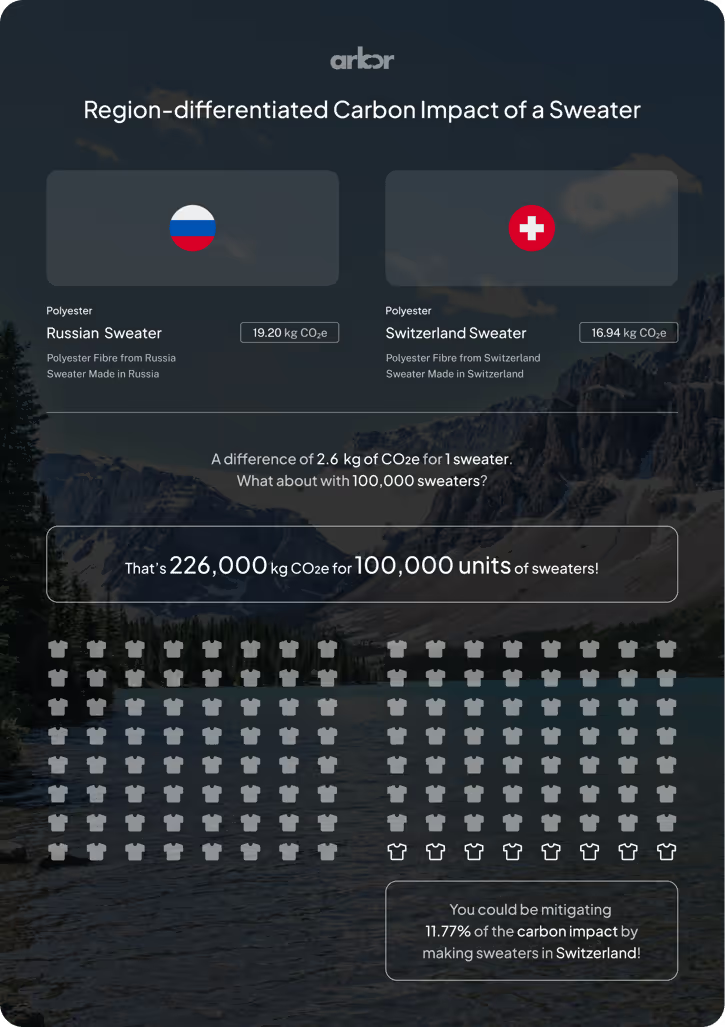"Is it up to individuals to change their lifestyles, and is it up to sacrifice to fix climate change? Or is it up to system-wide solutions at the levels of governments, states, companies, and large organizations? This debate will never end, but I have an answer. My answer is, 'Yes.'"
- Katherine Hayhoe, Canadian Climate Scientist at Texas Tech University
Global emissions primarily stem from two sources: companies and their industrial processes and everyday citizens. While both contribute to greenhouse gas emissions, it is essential to recognize the significant impact of industrial activities on the environment.
This post explores the breakdown of global emissions, distinguishing between emissions caused by companies and those resulting from individual actions. Additionally, we will delve into the role of data analysis and technology and how technological solutions like Arbor simplify the process of understanding a company's carbon impact and how to jump-start a carbon reduction plan.
Where do global emissions come from?
Global emissions originate from various sources, including industrial processes, energy production, transportation, and deforestation, which are major contributors. These activities release significant amounts of carbon dioxide (CO2), methane (CH4), and other greenhouse gases that trap heat in the Earth's atmosphere, intensifying the impacts of climate change. Carbon calculations play a vital role in understanding and addressing these emissions, garnering more attention and adoption compared to other impact categories – read more about how and why we calculate carbon emissions on our blog.
Fossil fuel use stands out as the primary source of CO2 emissions. Human-induced activities such as deforestation, land clearing for agriculture, and soil degradation also contribute to CO2 emissions.
According to the Environmental Protection Agency (EPA), global carbon emissions from fossil fuels have experienced a significant increase since 1900. Specifically, since 1970, CO2 emissions have risen by approximately 90%, with fossil fuel combustion and industrial processes accounting for about 78% of the total greenhouse gas emissions increase from 1970 to 2011. Agriculture, deforestation, and other land-use changes have been the second-largest contributors to carbon emissions.
How much do companies & people emit globally?
In 2022, companies and people have emitted over 36.8 Gigatonnes (Gt) of CO2 globally, according to the International Energy Agency (IEA). That’s 36,800,000,000 tonnes of carbon dioxide (CO2), equivalent to the weight of 111,200 Empire State Buildings. And that’s just in 2022 alone. CO2 has increased by 0.9% since 2021.
How much does each sector contribute to global emissions?
The sectoral breakdown of 2022 CO2 emissions reveals broadly consistent patterns to previous years.

Company vs. people emissions
Although individuals' actions contribute to emissions through energy consumption, transportation, and other day-to-day activities, the magnitude of emissions generated by companies is much greater. The industrial sector, including power generation, manufacturing, and construction, account for a substantial portion of global emissions.
Understanding the difference between an individual’s impact and a large company’s is essential. Not just to reduce emissions from industrial manufacturing, power generation, and construction but also as a lever to incentive their consumers to make more carbon-smart purchases.
For those looking to minimize their travel-related carbon footprint, several effective strategies are available, including choosing low-emission transportation, practicing carbon offsetting, and packing light. A comprehensive guide offering additional practical tips and insights for environmentally conscious travelers can be found in this resource from Sustainoverse on smart strategies to reduce travel carbon footprint.
When it comes to Gen-Z & shopping, this Fast Company article said this:
“Gen Z’s climate anxiety and aspiration for sustainable living are at odds with their love of shopping. Of those surveyed, 58% of Gen Zers in the U.S. “strongly” and “somewhat” agree that they need a lot of material possessions to be happy. They remain loyal to fast-fashion like Shein and mass retailers like Walmart and Amazon, where they can get more for their money.”
This dichotomy of climate education with consumerism is how businesses can leverage climate guilt to shift the purchasing pendulum and help consumers make conscious choices. Companies need to provide enhanced value and impact for their money to get there. This entails reimagining business models, materials used, and marketing strategies so sustainable shopping feels rewarding.
The impact of fabric and production location choices on carbon emissions
Time and time again, we hear businesses express the challenge of sourcing data throughout their supply chain or dealing with an overwhelming volume of information. This issue is particularly prevalent since global brands like the H&M Group and Zalando faced criticism for misleading data communication, leading many companies to doubt its accuracy.
For example, we examined the significance of fabric and production location choices from two locations. One from Russia, where we would all assume the data is hard to collect, and another from a neutral source in the EU, Switzerland. We looked at the manufacturing impact of the respective carbon emissions.
Fabric and Production Location Choices
Comparing the carbon emissions of different materials and production locations is a valuable exercise in understanding their environmental impact. Let's take a look at the data:
Polyester vs. Polyester (Russian-made vs. responsibly sourced)
- Polyester Fiber from Russia and sweater made in Russia: 19.20 kg CO2e
- Polyester Fiber from Switzerland and a sweater made in Switzerland: 16.94 kg CO2e

Analyzing the difference:
2.6 kg. That’s it?
Although the numerical difference between 19.20 kg CO2e and 16.94 kg CO2e may appear insignificant for an individual sweater, it makes a big difference considering that most companies don’t just produce one sweater but hundreds or thousands at a time. Apparel brands commonly place orders for thousands or even hundreds of thousands of units. For example, if 100,000 units of a polyester sweater are procured using the two fibre and fabric location combinations mentioned, the carbon emission difference would add up to 226,000 kg CO2e. This highlights the substantial impact fabric and production location choices can have on a brand's overall carbon footprint. Take Shien, for example, the world’s largest fast fashion producer, it releases 6,000 new items on its website every day.
And according to the Time article, Shein’s Fast Fashion Dominance Comes at a High Cost, the company’s mass production “leaves about 6.3 million tons of carbon dioxide a year in its trail—a number that falls well below the 45% target to reduce global carbon emissions by 2030, which the U.N. has said is necessary for fashion companies to implement to help limit global warming.”
Shaping consumer behaviour:
The impact of fabric and production location extends beyond businesses, as informed consumers now actively seek sustainable products aligned with their values. This shift in consumer behaviour incentivizes brands to adopt carbon-smart manufacturing practices and collaborate with transparent supply chain partners. And as we stated in our Gen Z example, companies can maintain consumer loyalty while reducing their carbon impact.
In addition, regulatory measures are being implemented to hold brands accountable for their environmental impact. Mandatory reporting of scope 3 emissions is anticipated for brands in certain countries within the next two years – read our post on the proposed EU Green Claims Directive for all the details.
Four ways to reduce company emissions:
Companies are vital in significantly impacting change by adopting sustainable practices and an effective carbon reduction strategy. To achieve a substantial impact on the cumulative effect of their emissions, here are four strategies companies can put in place:
- Implementing energy-efficient technologies and practices, such as optimizing industrial processes, improving insulation, and utilizing efficient transportation systems, while also transitioning to renewable energy sources like solar, wind, and hydroelectric power, can significantly reduce emissions.
- Implementing a simplified carbon management system that aims to minimize the carbon footprint of an organization, industry, or society. By enabling businesses to calculate their carbon impact accurately, covering every facet of their scope 3 supply chain operations helping companies to implement those energy-efficient technologies and practices.
- Sustainable supply chains: Companies can work towards greener supply chains by partnering with suppliers and other supply chain partners that prioritize emissions reduction, minimizing waste and resource consumption throughout the production and distribution processes.
- Data, data, data. But not just any data. We are talking about verifiable, accurate, and regulatory-compliant data analytical practices that look holistically at the impact of products and provide valuable insights to companies leveraging advancements in AI and ML to increase the scope of data available. As well as data practices that prioritize regulatory complacency and innovative policies like the EU’s newly proposed Digital Product Passport – a digital traceability ID that aims to enhance environmental impact reporting throughout the entire manufacturing value chain, covering every stage from material extraction to production and recycling.
Data story or data daydream?
In a recent statement, Alan Boehme, the CTO of H&M, stated that “H&M will move from being a fashion company to becoming a data company," His advice to the industry:
“Data is everything today. We must listen to the stories data has to tell and not simply confine them to supporting only the story we want to tell. When you talk about innovation, most people think that you start doing new things with data, that you have to start from scratch, but most of the time, the answers are already there, it's just about innovating and connecting the missing pieces,"
And we couldn’t agree more with this statement. But with the questionable history of H&M’s data disclosure practices, we hope this advice is a story with a solution and not just a data daydream.
Four ways Arbor makes it easy to understand carbon emissions
At Arbor, we understand the complex nature of carbon impacts and the need for accessible solutions. Our platform offers a range of features to make it easy for companies to understand and manage their carbon footprint. Arbor is designed to be industry agnostic, catering to diverse sectors and supply chains. Our user-friendly interface and comprehensive insights simplify the understanding and management of carbon emissions, empowering companies to manage their carbon footprint.
Here are just a few of the ways we help:
- Data collection and analysis lie at the core of our capabilities. We integrate diverse data sources, including energy consumption, emissions data, and supply chain details, providing a comprehensive view of a company's carbon footprint. Our platform ensures accurate calculations and a holistic understanding of environmental performance by leveraging advanced data analysis techniques.
- Real-time impact results enable companies to track their product-level emissions fast and effectively. This feature empowers businesses to continuously monitor their environmental performance, identify areas for improvement, and make data-driven decisions to hit their carbon reduction targets.
- With our prototyping feature, companies can simulate and evaluate the impact of various sustainability initiatives and strategies. By modelling different scenarios on a material-level basis, businesses can assess the effectiveness of potential measures and set achievable decarbonization targets.
- Reporting and transparency are also key aspects of our software. Arbor streamlines the reporting process by generating clear, concise reports aligning with industry standards and regulatory requirements. These reports enhance transparency and facilitate effective communication with stakeholders, including investors, customers, and regulatory bodies.
Next steps
Understanding sources of carbon emissions and taking concrete actions to reduce them is paramount, and the industrial sector's impact is particularly significant. Moving beyond the initial focus on avoiding plastic straws and using reusable grocery bags, cycling instead of driving, and reducing meat consumption is crucial. At the same time, these choices are essential but cannot address businesses' vast impact on consumers and the environment.
Leveraging data analysis and technology platforms like Arbor and advancements in technology and data analytics facilitate the collection, analysis, and dissemination of all the steps to reduce global emissions effectively.
Measure your carbon emissions with Arbor
Simple, easy carbon accounting.




%20Directive.webp)


.webp)











%20Arbor.avif)





%20Arbor.avif)


.avif)






%20Arbor%20Canada.avif)

.avif)
%20Arbor.avif)
.avif)






_.avif)
.avif)
%20Arbor.avif)




%20Software%20and%20Tools.avif)





.avif)
.avif)




%20EU%20Regulation.avif)












.avif)


%20Arbor.avif)









_%20_%20Carbon%20101.avif)







.avif)

.avif)
.avif)









